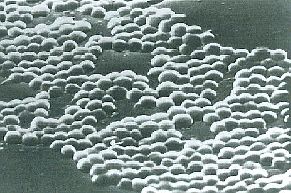Tokyo Food Safety Information Center » Good things to know » The microorganisms which cause food poisoning » Staphylococcus aureus
Staphylococcus aureus
Characteristics

The name Staphylococcus, meaning “grape-cluster berry,” is derived from the bacteria’s grape-like appearance under the microscope. Staphylococcus aureus is a common suppurative disease which is not only a cause of food poisoning but also often found in boils, pimples, and athlete’s foot.
Accordingly, Staphylococcus aureus is frequently detected in the throats and noses of even healthy people and can also commonly be found close at hand on the skin, in the lungs, and adhering to dust from animals.
Staphylococcus aureus generates a toxin called enterotoxin when it multiplies in food. When eaten with food, this toxin causes harm in humans.
Staphylococcus aureus itself is weak to cooking but its toxins do not disintegrate even if heated at 100° C for 20 minutes. This bacteria can also reproduce even in environments without oxygen and generate its toxins even if a certain amount of salt is present.
Which foods can cause Staphylococcus aureus infection?
Many foods can result in infection from Staphylococcus aureus, including cooked foods such as sushi, meat, eggs, and milk as well as confections.
What are the symptoms of Staphylococcus aureus infection?
The incubation period for Staphylococcus aureus is 30 minutes to 6 hours (with an average of 3 hours). Primary symptoms are nausea, vomiting, and stomach ache. Staphylococcus aureus may also be accompanied by diarrhea and usually does not cause high fever.
What are the key points to preventing Staphylococcus aureus infection?
- Persons with cuts or abscesses on their hands should not come in direct contact with or prepare food.
- Thoroughly wash and disinfect hands.
- Store food at 10° C or less to prevent bacteria from multiplying.
- Wear a hat and mask when preparing food.